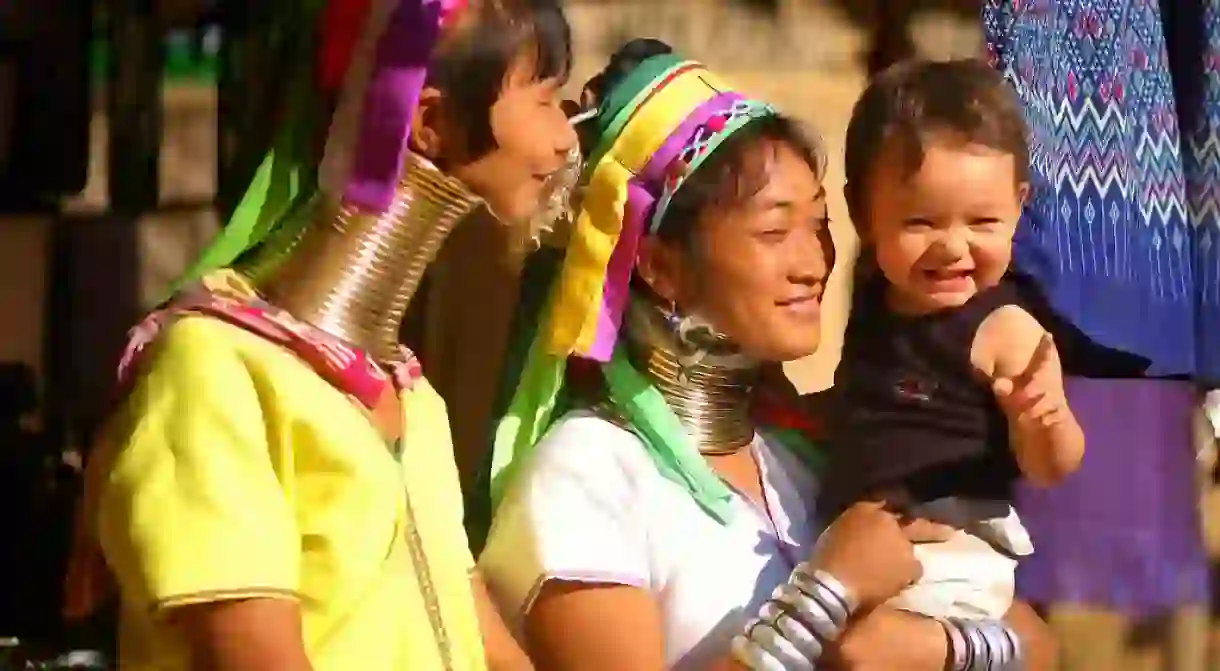The History of Thailand’s Kayan People

In the northern Thai provinces (such as Mae Hong Son) live Thailand’s Kayan people, communities of displaced ethnic minorities of Tibeto-Burman origins, who originally fled strife and persecution in neighbouring Myanmar.
What’s in a name?
The Kayan form one of a number of sub-groups of Myanmar’s Red Karen people, also known as the Karenni. The Kayan group are also referred to colloquially in English as the ‘long-neck people’ for the trademark brass neck rings traditionally worn by its women, which appear to lengthen the neck. Alongside the Kayan in northern Thailand are the so-called Kayaw, or ‘long-ear people’, also originating from Myanmar.

The specific group of Kayan people identified by their traditional neck coils are, in some contexts, instead referred to using the word Padaung, a term in the native language of Myanmar’s Shan state. However, many of the group that has now resettled in northern Thailand are believed to consider this term pejorative, and instead prefer to call themselves Kayan.
How the Kayan arrived in Thailand
The existence of the Kayan in northern Thailand began in the late 1980s, when conflict between the Myanmar army and rebel forces forced Kayan tribes to flee to Thai border areas, from where they sought refuge in Thailand and were housed in a number of refugee camps. Among these was a self-sufficient camp open to tourists who wished to see the Kayan women’s striking neck coils and learn about their way of life. Today three villages remain accessible to tourists, while the main Karenni refugee camp is not, and estimates put the number of Kayan people in Thailand – out of a worldwide population of approximately 130,000 – at around 600.
[jwplayer bJhm2Ccz-RnIdcM25]
The history of the ‘long-neck’ coil
The Kayan people are perhaps most well-known and recognised, including by travellers interested in visiting their villages and learning about their way of life, for the distinctive brass coils worn around the necks of the females in the community. These coils, worn by Kayan women from as early as the age of five, appear to stretch the neck to inconceivable lengths. Hence, the Kayan have attracted the colloquial name of the ‘long-neck people’. However, there is no growth or lengthening of the neck itself that takes place as a result of wearing these coils – rather, the coils appear to cause the collarbone to become deformed, which in turn contributes to the appearance for which we know the Kayan women.

While some Kayan women in the last decade or so have opted to stop wearing the brass rings, many continue to do so. Indeed, some Kayan women are keen to stress that they wear the rings of their own choice, and that they see this as an expression of the traditional Kayan culture and as a way to keep it alive. The origins of the custom are less clear – various explanations exist, ranging from attempts to make Kayan women less attractive as a means of deterring their enslavement by rival tribes, to entirely different efforts to enhance the women’s sexual attractiveness, all the way through to a desire to imitate the long neck of dragons, from which the group’s traditional religious beliefs hold that Kayan people are descended.
Challenges facing the Kayan in Thailand
While the Kayan people have escaped the strife they previously faced in Myanmar, they continue to encounter ongoing challenges while living in Thailand. Owing to the limited rights afforded to them as refugees, there are often restrictions placed on their ability to travel outside of their own villages, and Kayan children are not only ineligible for Thai citizenship but also often have limited educational opportunities.
One solution to overcoming the Kayan’s problems over the years has been for them to embrace tourism as a means of supporting themselves. However, the popularity among tourists of visits to the Kayan people’s remote villages in northern Thailand isn’t without its controversy. While some see downsides to tourists visiting Kayan villages – it’s true that, in some cases, little of the money spent by tourists makes it through to villagers themselves – it nevertheless provides a much-needed opportunity for the Kayan people to make money by selling handicrafts, as well as to ensure the ongoing preservation of their community’s traditional way of life by sharing it with the world.













